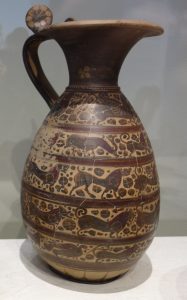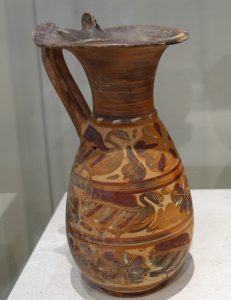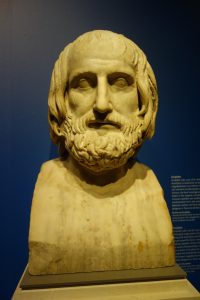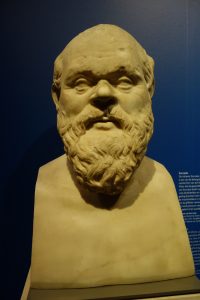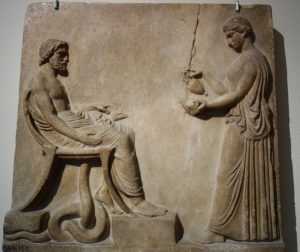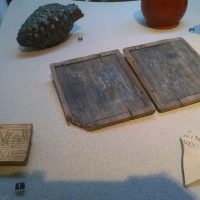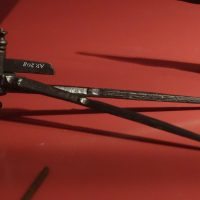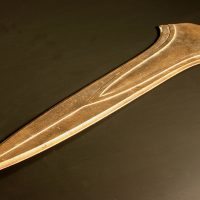Leiden, Netherlands is not exactly the first place that comes into mind when you think about ancient history. Even if you are in the city, you would most likely walk past the Rijksmuseum van Oudheden (National Museum of Antiquities) without noticing it. Hidden in an unremarkable building in the historic city center, it’s nothing like entering the magnificent building of the Louvre or the British Museum. Yet, judging the book by its cover would be a huge mistake. Once inside, right in the middle of the entrance hall, you are greeted with an actual Egyptian temple, built c. 2000 years ago, originally dedicated to Isis and later used as a Christian church, transported to the museum stone by stone from Taffeh, Egypt.

A real 2000-year-old Egyptian temple from the village Taffeh in the National Museum of Antiquities, Leiden. Photo © Ibolya Horvath
Splendour & Precision
Right next to the entrance I immediately found something new, the Splendour & Precision exhibition. It guides the visitor through the world of engraved gems and semi-precious stones with talismans, amulets, cylinder seals, rings, and other beautiful objects of exquisite craftsmanship, ranging from ancient Mesopotamia to the 19th century CE.
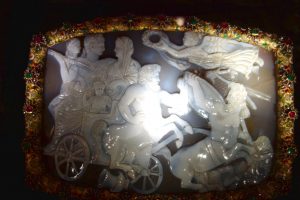
Gemma Constantiniana. Photo © Ibolya Horvath
One of the most spectacular pieces is the Gemma Constantiniana, a Roman cameo commemorating Constantine’s victory over Maxentius. The 28×21 cm (yes, about the size of an A4 sheet of paper, only it weighs 3 kg) cameo has an interesting history; during the 17th century it was owned by Peter Paul Rubens, the famous artist from Antwerp.

Collection of engraved gems. Photo © the Rijksmuseum van Oudheden
As probably all frequent museum visitors, usually I can approximately tell the age and the origin of items on display, not accurately of course, but I would never mistake a 16th-century rapier for a Roman gladius or Phoenician pottery for a Greek amphora. Interestingly, however, I was completely lost in these rooms and had to read every label. I’m sure experts can identify them better, but to my unpracticed eye it seemed impossible to tell an antique and a relatively modern piece apart. The incredible skill displayed in each piece is probably one of the reasons why collecting engraved gems and semi-precious stones was a rich men’s hobby in the 17th-19th centuries.
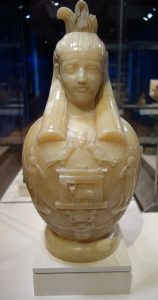
Osiris Canopus. Photo © Ibolya Horvath
Egypt, Land of Immortality
Most of the ground floor exhibition space is still closed, with refurbishments ongoing. Once finished, it will be the new home of the museum’s amazing Egyptian collection, opening in October. Until then, some of the highlights of their lavish collection are on display as part of the temporary exhibition Egypt, Land of Immortality. The theme, as you might have guessed, is the afterlife and burial practices. Besides the usual sarcophagi, mummies, canopic jars, sculptures of Egyptian deities, and papyri, you can also marvel at a few rare pieces like the 1st-century CE alabaster Osiris Canopus. This beautiful vase depicts the temple of Canopus, erected by Ptolemy III, and was found in Hadrian’s villa in Tivoli. Later on, Queen Anna Pavlovna received it as a gift from Pope Pious IX in 1846, and now it is part of the Royal Collection, The Hague.
Permanent Exhibitions
The first and second floors, as always, house the permanent exhibitions, the Classical World, the Near East, the Romans in the Netherlands, and the Archaeology of the Netherlands. I was particularly fond of the small – almost hidden – bedroom reconstructions of the Archaeology of Netherlands exhibit. It is all too easy to focus on the artefacts on display and miss these tiny hidden chambers. However, if you take the time to crawl into them, you are transported through time.
The rest of the permanent exhibitions is what you would expect to find in a museum of antiquities. While the museum has an impressive collection of Greek vases, amphorae, and all sorts of beautifully decorated both black- and red-figure Greek pottery, I for one prefer the Etruscan collection.
- Etruscan imitation of Corinthian pottery, c. 600-550 BCE. Photo © Ibolya Horvath
- Etruscan imitation of Corinthian pottery. Photo © Ibolya Horvath
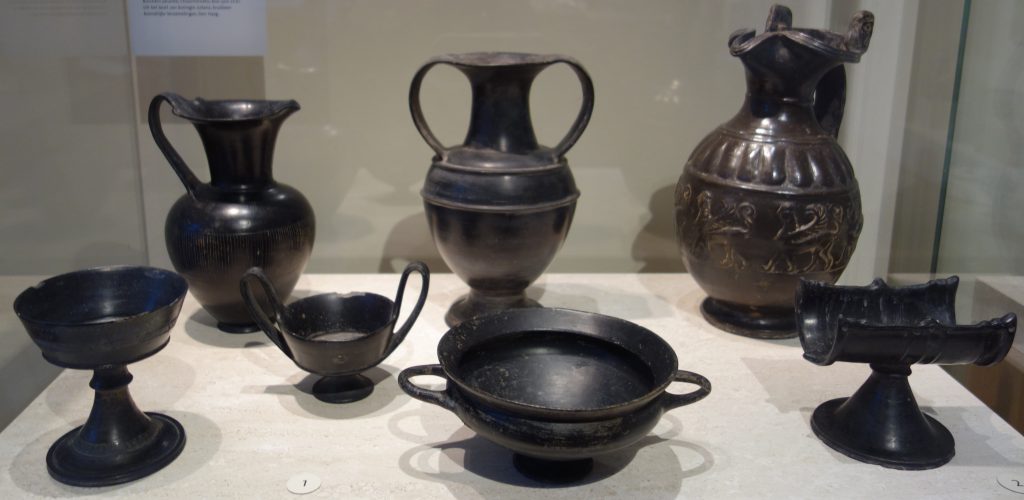
Etruscan black pottery. Photo © Ibolya Horvath
The Classical World wouldn’t be complete without the Gallery of Greek sculptures, however, despite the name, many of the exhibited reliefs, busts, and sculptures are in fact Roman copies of Greek originals. This, of course, does not diminish the artistic value in any way, it only attests the Greek influence on Rome.
- Portrait of Euripides, Roman copy the 4th-century BCE Greek original
- Portrait of Socrates, Roman copy of the Greek original from c. 380 BCE
- Asclepius & Hygieia, 1st-century CE marble from Italy. Photo © Ibolya Horvath
The Roman frontier ran right across the middle of the Netherlands. Thanks to the low-lying land, many Roman artefacts, including perishable materials, have been found largely intact preserved by the waterlogged conditions of marshes. Well-preserved wood such as a writing tablet (tabula) is a rare and precious find.
- Artefacts from the Roman frontier in the Netherlands. Photo © Ibolya Horvath
- Bronze measuring tool from Nijmegen, 2nd or 3rd century CE. Photo © Ibolya Horvath
Cutting-edge History
My personal favorite, is the temporary display Cutting-edge History. My fascination with beautifully designed, perfectly balanced, razor-sharp swords predestined me to spend most of my visit admiring the stunning pieces collected for this exhibition. The collection presented swords from every part of the world, covering thousands of years of history. One locally found beauty is the sword of the Chieftain of Oss, an elegant Iron Age blade, excavated from an elite grave in Oss, Noord-Brabant. The Mindelheim blade was bent, placed in a bronze situla (bucket), and buried with its owner.
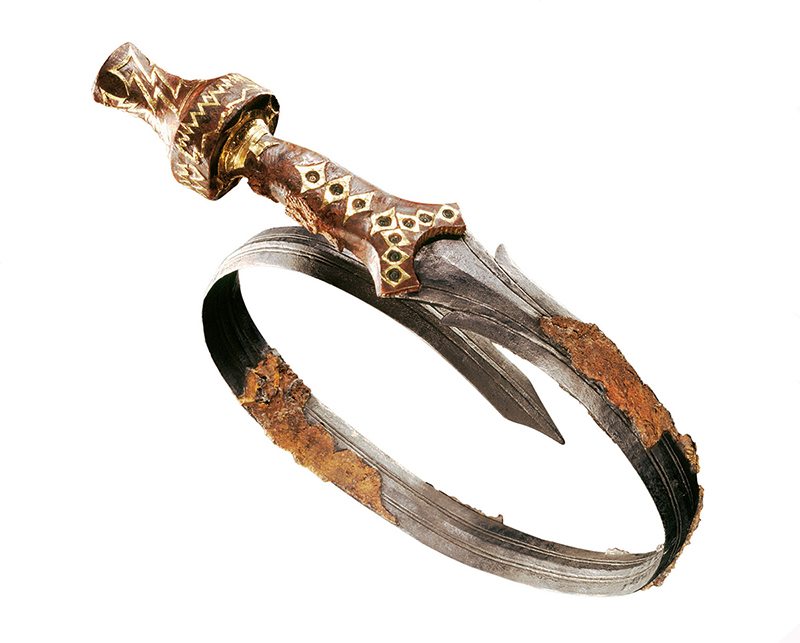
Sword of the Chieftain of Oss. Photo © the Rijksmuseum van Oudheden
Despite the fact that the exhibition includes the Dorestad sword, the sword of the chieftain of Oss, and the Rijkszwaard (the Sword of State, part of the Dutch Royal Regalia), the highlight is without doubt the collection of six large ceremonial blades from the Bronze Age. Two of them were found in the Netherlands, two in France, and two in Britain, and this exhibition has brought all six of them together. The Jutphaas blade dates to 1500-1300 BCE and was found in the province of Utrecht. The exhibition reunites it with its five brothers, the biggest of the six, the Oxborough being lent by the British Museum.
- Sword of Jutphaas. Photo © the Rijksmuseum van Oudheden
- Sword of Oxborough. Photo © Ibolya Horvath
Rijksmuseum van Oudheden
Rapenburg 28, 2311 EW Leiden
Opening hours
- Tuesdays to Sundays: 10.00 – 17.00
- During all school holidays also open on Mondays: 10.00 – 17.00
- Closed on: 27 April, 3 October, 25 December and 1 January
Entrance fees
- Adults: €9,50
- Children until 5 years: free
- Children 5 to 17 years: €3
- Family ticket (2 adults + 2 children 5-17 years): €22 (+ €3 per extra child)
- Dutch ‘Museum card’ holders: free
- Seniors (65 and older with ID): €7,50

